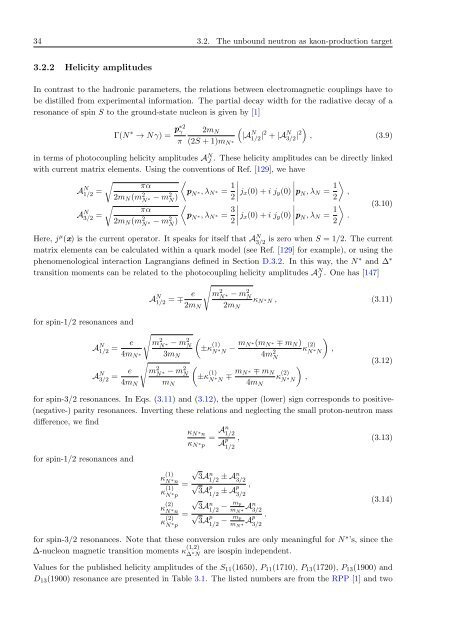Download Thesis in Pdf Format - Theoretical Nuclear Physics and ...
Download Thesis in Pdf Format - Theoretical Nuclear Physics and ...
Download Thesis in Pdf Format - Theoretical Nuclear Physics and ...
You also want an ePaper? Increase the reach of your titles
YUMPU automatically turns print PDFs into web optimized ePapers that Google loves.
34 3.2. The unbound neutron as kaon-production target3.2.2 Helicity amplitudesIn contrast to the hadronic parameters, the relations between electromagnetic coupl<strong>in</strong>gs have tobe distilled from experimental <strong>in</strong>formation. The partial decay width for the radiative decay of aresonance of sp<strong>in</strong> S to the ground-state nucleon is given by [1]Γ(N ∗ → Nγ) = p∗2 γπ2m N(2S + 1)m N ∗(|A N 1/2 |2 + |A N 3/2 |2) , (3.9)<strong>in</strong> terms of photocoupl<strong>in</strong>g helicity amplitudes A N J. These helicity amplitudes can be directly l<strong>in</strong>kedwith current matrix elements. Us<strong>in</strong>g the conventions of Ref. [129], we have√A N 1/2 = πα〈p2m N (m 2 N− m 2 ∗ N ) N ∗, λ N ∗ = 1 2∣ j x(0) + i j y (0)∣ p N, λ N = 1 〉,2√A N 3/2 = πα〈p2m N (m 2 N− m 2 ∗ N ) N ∗, λ N ∗ = 3 2∣ j x(0) + i j y (0)∣ p N, λ N = 1 〉 (3.10).2Here, j µ (x) is the current operator. It speaks for itself that A N 3/2is zero when S = 1/2. The currentmatrix elements can be calculated with<strong>in</strong> a quark model (see Ref. [129] for example), or us<strong>in</strong>g thephenomenological <strong>in</strong>teraction Lagrangians def<strong>in</strong>ed <strong>in</strong> Section D.3.2. In this way, the N ∗ <strong>and</strong> ∆ ∗transition moments can be related to the photocoupl<strong>in</strong>g helicity amplitudes A N J. One has [147]√A N 1/2 = ∓ e m 2 N ∗ − m2 Nκ N2m N 2m ∗ N , (3.11)Nfor sp<strong>in</strong>-1/2 resonances <strong>and</strong>A N 1/2 = e4m N ∗A N 3/2 =√m 2 N ∗ − (m2 N±κ (1)3m NN ∗ N − m N ∗(m N ∗ ∓ m N)4m 2 N√e m 2 N ∗ − (m2 N±κ (1)N4m N m ∗ N ∓ m N ∗ ∓ m Nκ (2)N N 4m ∗ NN),)κ (2)N ∗ N,(3.12)for sp<strong>in</strong>-3/2 resonances. In Eqs. (3.11) <strong>and</strong> (3.12), the upper (lower) sign corresponds to positive-(negative-) parity resonances. Invert<strong>in</strong>g these relations <strong>and</strong> neglect<strong>in</strong>g the small proton-neutron massdifference, we f<strong>in</strong>dfor sp<strong>in</strong>-1/2 resonances <strong>and</strong>κ (1)N ∗ nκ (1)N ∗ pκ (2)N ∗ nκ (2)N ∗ pκ N ∗ nκ N ∗ p= An 1/2A p , (3.13)1/2√3An1/2± A n 3/2= √3Ap,1/2 ± Ap 3/2√3An1/2− mpm=N ∗ An 3/2√3Ap1/2 − .mpm N ∗ Ap 3/2(3.14)for sp<strong>in</strong>-3/2 resonances. Note that these conversion rules are only mean<strong>in</strong>gful for N ∗ ’s, s<strong>in</strong>ce the∆-nucleon magnetic transition moments κ (1,2)∆ ∗ Nare isosp<strong>in</strong> <strong>in</strong>dependent.Values for the published helicity amplitudes of the S 11 (1650), P 11 (1710), P 13 (1720), P 13 (1900) <strong>and</strong>D 13 (1900) resonance are presented <strong>in</strong> Table 3.1. The listed numbers are from the RPP [1] <strong>and</strong> two















